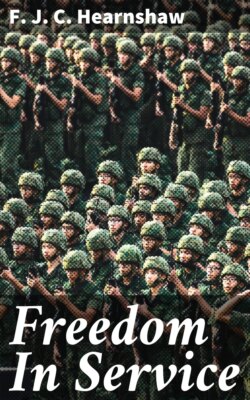Читать книгу Freedom In Service - F. J. C. Hearnshaw - Страница 12
На сайте Литреса книга снята с продажи.
IV. TUDOR AND STUART DEVELOPMENTS
ОглавлениеTable of Contents
The Wars of the Roses, so fatal to the feudal nobility, left the national militia the only organized force in the country. The Tudor period, it is true, saw the faint foreshadowing of a regular army in Henry VII's Yeomen of the Guard, and the nucleus of a volunteer force in the Honourable Artillery Company, established in London under Henry VIII. But these at the time had little military importance, and England remained dependent for her defence throughout the sixteenth century, that age of unprecedented prosperity and glory, upon her militant manhood. Hence the Tudor monarchs paid great attention to the maintenance and equipment of the militia. The practice (which had grown up in the later Middle Ages) of limiting the normal call to arms to a certain quota of men from each county was revived. If the required numbers were not forthcoming compulsion was employed. Statutes were passed making discipline more rigid. Lords Lieutenant were instituted to take over the command, with added powers, from the Sheriffs. An important Mustering Statute (1557) was enacted, graduating afresh the universal liability to service, and making new provision for weapons and organization.[16] William Harrison, writing in 1587, said: "As for able men for service, thanked be God! we are not without good store; for by the musters taken 1574–5 our numbers amounted to 1,172,674, and yet were they not so narrowly taken but that a third part of this like multitude was left unbilled and uncalled."[17] This from a population estimated at less than six million all told! Such was the host on which England relied for safety in 1588, if by chance the galleons of Spain should elude the vigilance of Drake and should land Parma's hordes upon our shores. Well might the country feel at ease behind such a fleet and with such a virile race of men to second it.
The Stuarts did not take kindly to the English militia. It was too democratic, too free. James I, in the very first year of his reign, conferred upon its members the seductive but fatal gift of exemption from the burden of providing their own weapons.[18] As he himself took care not to provide them too profusely, the force speedily lost both in efficiency and independence. The Civil War hopelessly divided it, as it did the nation, into hostile factions. The Royalist section was ultimately crushed, while the Parliamentary section was gradually absorbed into that first great standing army which this country ever knew, the New Model of 1645. For fifteen years the people groaned under the dominance of this arbitrary, conscientious, and very expensive force. Then, in 1660, came the Restoration, and with it the disbanding of the New Model and the re-establishment of the militia. The country went wild with joy at the recovery of its freedom.
Charles II, however, was bent on securing for his own despotic purposes a standing army. Hence he obtained permission from Parliament to have a permanent bodyguard, and he gradually increased its numbers until he had some 6,000 troops regularly under his command. James II increased them to 15,000, and by their means tried to overthrow the religion and the liberties of the nation. He was defeated and driven out; but his effort to establish a military despotism made the name of "standing army" stink in the nostrils of the nation. "It is indeed impossible," said one of the leading statesmen of the early eighteenth century, "that the liberties of the people can be preserved in any country where a numerous standing army is kept up."[19] The national militia continued, as of old, to stand for freedom and self-government. The voluntarily enlisted standing army was regarded as the engine and emblem of tyranny.
